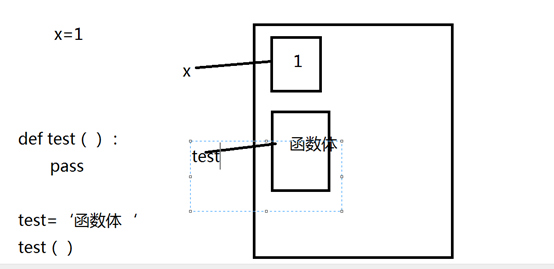1、 列表生成器:代码例子
1 a=[i*2 for i in range(10)] 2 print(a) 3 4 运行效果如下: 5 D:python35python.exe D:/python培训/s14/day4/列表生成式.py 6 [0, 2, 4, 6, 8, 10, 12, 14, 16, 18] 7 8 Process finished with exit code 0
2、高阶函数
变量可以指向函数,函数的参数能接受变量,即把一个函数名当做实参传给另外一个函数
返回值中包涵函数名
代码例子:
1 def test(): 2 print("int the test") 3 4 def test2(func): 5 print("in the test2") 6 print(func) 7 func() 8 9 test2(test) 10 运行效果如下: 11 D:python35python.exe D:/python培训/s14/day4/高阶函数.py 12 in the test2 13 <function test at 0x000000000110E268> #这里是test的内存地址 14 int the test 15 16 Process finished with exit code 0
3、装饰器
装饰器:本质是函数,(装饰其他函数)就是为其他函数添加附加功能
装饰器原则:
a.不能修改被装饰的函数的源代码
b.不能修改被装饰的函数的调用方式
实现装饰器的知识储备:
a、函数即“变量”
b、高阶函数
c、嵌套函数
高阶函数+嵌套函数=====装饰器

高阶函数:
a.把一个函数名当做实参传给另外一个函数
b.返回值中包含函数名
代码例子
1 import time 2 def timeer(func): 3 def warpper(): 4 start_time=time.time() 5 func() 6 stop_time=time.time() 7 print("the fun runn time is %s" %(stop_time-start_time)) 8 return warpper 9 @timeer 10 def test1(): 11 time.sleep(3) 12 print("in the test1") 13 14 test1() 15 运行结果如下: 16 D:python35python.exe D:/python培训/s14/day4/装饰器.py 17 in the test1 18 the fun runn time is 3.000171661376953 19 20 Process finished with exit code 0
带参数的装饰器
1 import time 2 3 def timer(func): 4 def deco(*args,**kwargs): 5 start_time=time.time() 6 func(*args,**kwargs) 7 stop_time=time.time() 8 print("the func runn time is %s" %(stop_time-start_time)) 9 return deco 10 11 @timer #test1 = timer(test1) 12 def test1(): 13 time.sleep(3) 14 print("in the test1") 15 16 @timer 17 18 def test2(name,age): 19 print("name:%s,age:%s" %(name,age)) 20 21 test1() 22 test2("zhaofan",23) 23 运行结果如下: 24 25 D:python35python.exe D:/python培训/s14/day4/装饰器3.py 26 in the test1 27 the func runn time is 3.000171661376953 28 name:zhaofan,age:23 29 the func runn time is 0.0 30 31 Process finished with exit code 0
终极版的装饰器
1 import time 2 user,passwd = "zhaofan","123" 3 def auth(auth_type): 4 print("auth func:",auth_type) 5 def outer_wrapper(func): 6 def wrapper(*args,**kwargs): 7 if auth_type=="local": 8 username = input("Username:").strip() 9 password = input("Password:").strip() 10 if user == username and passwd== password: 11 print("�33[32;1mUser has passed authentication�33[0m") 12 res = func(*args,**kwargs) 13 print("------after authentication") 14 return res 15 else: 16 exit("�33[31;1mInvalid username or password�33[0m") 17 elif auth_type=="ldap": 18 print("没有ldap") 19 return wrapper 20 return outer_wrapper 21 22 def index(): 23 print("welcome to index page") 24 @auth(auth_type="local") 25 def home(): 26 print("welcome to home page") 27 return "from home" 28 @auth(auth_type="ldap") 29 def bbs(): 30 print("welcome to bbs page") 31 32 index() 33 print(home()) 34 bbs() 35 36 37 运行结果如下: 38 D:python35python.exe D:/python培训/s14/day4/装饰器4.py 39 auth func: local 40 auth func: ldap 41 welcome to index page 42 Username:zhaofan 43 Password:123 44 User has passed authentication 45 welcome to home page 46 ------after authentication 47 from home 48 没有ldap 49 50 Process finished with exit code 0
4、通过列表生成式,我们可以直接创建一个列表。但是,受到内存限制,列表容量肯定是有限的。而且,创建一个包含100万个元素的列表,不仅占用很大的存储空间,如果我们仅仅需要访问前面几个元素,那后面绝大多数元素占用的空间都白白浪费了。
所以,如果列表元素可以按照某种算法推算出来,那我们是否可以在循环的过程中不断推算出后续的元素呢?这样就不必创建完整的list,从而节省大量的空间。在Python中,这种一边循环一边计算的机制,称为生成器:generator。
1 a = [x for x in range(10)] 2 print(a) 3 4 g=(x for x in range(10)) 5 print(g) 6 运行结果如下: 7 D:python35python.exe D:/python培训/s14/day4/生成器.py 8 [0, 1, 2, 3, 4, 5, 6, 7, 8, 9] 9 <generator object <genexpr> at 0x0000000000B01DB0> 10 11 Process finished with exit code 0
生成器只有一个方法:__next__()
generator保存的是算法,每次调用next(g),就计算出g的下一个元素的值,直到计算到最后一个元素,没有更多的元素时,抛出StopIteration的错误。
1 g=(x for x in range(10)) 2 3 for i in g: 4 print(i) 5 6 7 运行结果如下: 8 9 D:python35python.exe D:/python培训/s14/day4/生成器的调用.py 10 0 11 1 12 2 13 3 14 4 15 5 16 6 17 7 18 8 19 9 20 21 Process finished with exit code 0
5、可以直接作用于for循环的数据类型有以下几种
一类是集合数据类型,如list、tuple、dict、set、str等;
一类是generator,包括生成器和带yield的generator function。
这些可以直接作用于for循环的对象统称为可迭代对象:Iterable。
可以使用isinstance()判断一个对象是否是Iterable对象
可以被next()函数调用并不断返回下一个值的对象称为迭代器:Iterator。
生成器都是Iterator对象,但list、dict、str虽然是Iterable,却不是Iterator。
凡是可作用于for循环的对象都是Iterable类型;
凡是可作用于next()函数的对象都是Iterator类型,它们表示一个惰性计算的序列;
集合数据类型如list、dict、str等是Iterable但不是Iterator,不过可以通过iter()函数获得一个Iterator对象。
6、json和pickle